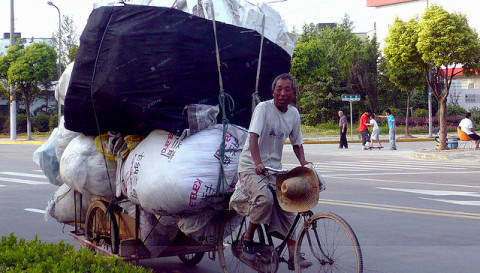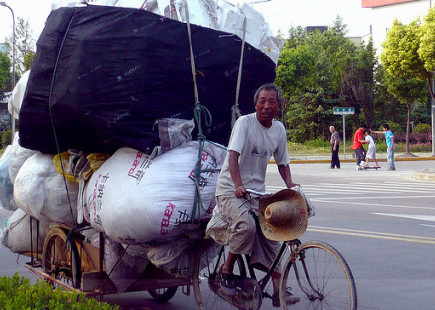China’s stock market crash: Symptom of a bigger crisis
Regiones
The spectacular cratering of the Shanghai stock market, which lost nearly 40 percent of its value in just 10 weeks, is a sign of a much bigger problem.

KSheenan @Flickr

KSheenan @Flickr
It is always amazing how the stock market pulls big surprises over those who should know better. The momentous rise in share prices in the Shanghai stock exchange from mid-2014 to the middle of this year, when the bourse’s composite index shot up by 150 percent, should have been a strong indication of what Alan Greenspan labeled “irrational exuberance,” of an impending collapse in stock prices owing to their severe deviation from the real value of assets being traded. But, like Greenspan during the 2008 Wall Street crisis, neither the Chinese investors, nor foreign investors, nor the Chinese government seemed prepared when the market began to crater mid-June and the Shanghai composite index plunged by 40 percent in a few weeks’ time, triggering a global collapse of stock prices, forcing Beijing to intervene and buy up market shares, and when that failed, prompting it to devalue the yuan.
The Beijing stock market collapse marks the deepening of the third stage of the contemporary crisis of global capitalism. The first phase was the Wall Street financial bust in 2008. The second was the European sovereign debt crisis, which dovetailed into the Wall Street rout the following year. Massive stimulus programs, such as China’s US$585 billion package in 2009, enabled the so-called big emerging economies or BRICS (the acronym for Brazil, Russia, India, China, and South Africa) to stave off the depressive effects of the U.S. and European recessions following the financial bust, leading analysts such as Nobel Prize laureate Michael Spence to think that they would replace the traditional economic hegemons as the new drivers of the world economy and herald a new wave of global growth. But this optimism proved short-lived with the onset of the third phase of the global crisis as growth began to slow down in the BRICS beginning around 2012.
The Struggle over Economic Strategy
When then President Hu Jintao and Prime Minister Wen Jiabao launched China’s massive stimulus program – at US$585 billion, the biggest in the world in relation to the size of the economy – their aim went beyond providing a temporary relief while awaiting the recovery of the country’s main export markets in the United States and Europe. The stimulus was intended to be the cutting edge of an ambitious drive to make domestic consumption instead of export production the center of gravity of the economy.
Shifting to stimulating domestic consumption made economic sense, not only because export markets were volatile but also because owing to overinvestment there was much unused capacity in the economy. Also, the stimulus made sense from an equity point of view since it would place more purchasing power in the hands of the vast majority of peasants and workers, who had been disadvantaged by the priority given to export-oriented industry and profits. Also, China’s leadership was becoming very sensitive to criticism about the massive trade surpluses the country was running with its export-led rapid growth strategy, with external voices demanding “rebalancing,” that is, that the country consume more imports from its main trading partners.
The problem was that the shift was not just a case of changing macroeconomic priorities; it would also entail transforming the composition of winners and losers. The political economy of export-oriented rapid growth had created a set of political and economic interests that converged and congealed over the last 30 years. These included government planning bodies like the National Development Reform Commission and the Ministry of Finance, both of which had fathered the strategy of export-led industrialization; export-oriented state and private enterprises; local government and Communist Party bodies in the coastal provinces; and state-owned construction firms that built the infrastructure that undergirded the economic strategy. These elites were well entrenched in the leadership of the Communist Party. Though foreign investors were not represented in the party, their interests were well served by policies that favored their interests over those of local privately owned small and medium enterprises.
One key interest of this lobby has been the undervaluation of the yuan to make Chinese exports competitive. Another policy favored by this grouping has been keeping deposit rates low – in fact, negative, when inflation is taken into account – so that people’s savings could be relent at low rates to favor export-oriented firms and construction companies. Economists termed this policy one of “financial repression.”
As for the losers, these included small and medium entrepreneurs serving the local market, workers, peasants, and the general population in their roles as savers and consumers – in short, as the economist Hongying Wang put it, all those who have “suffered from the financial and public finance systems that have deprived them of their fair share of the national wealth.”
Hijacking the Stimulus, Frustrating Reform
Not only did the export-led rapid growth lobby manage to neutralize the plan to make domestic consumption the cutting edge of the economy. It was also able to hijack the massive stimulus program that had been intended to place money and resources in the hands of consumers. According to statistics from Caijing Magazine, some 70 percent of the 4 trillion yuan stimulus program went to infrastructure, while only 8 percent went to social welfare expenditures, that is, spending for affordable housing, health care, and education.
An anti-consumption, pro-investment, and pro-infrastructure bias is built into the current growth model, says Wang, “since infrastructure is essential for attracting investment and promoting local economic development. Given the emphasis on GDP growth rate as a major criterion for their political advancement, officials are highly motivated to pour money into various infrastructure projects.” In contrast, there are few near term material and career benefits in expanding social welfare programs.
Financial Repression Sparks Speculation
Financial repression, that is, a policy of maintaining low rates for savers, has had particularly pernicious consequences. With little money to be earned from their bank deposits, a great number of the Chinese public gravitated toward the real estate and property markets. This move was encouraged by the authorities, worried about the public’s discontent with the lack of profitable outlets for their savings. Encouragement included easing lending requirements at the state banks to allow people to invest not only their savings but also borrowed cash.
Speculation in property was the investment of choice for many years, but, as in the United States during the subprime property bubble, the market attracted too many investors, leading to a bust at the beginning of 2014, with the price collapse leading to thousands of unfinished skyscrapers, ghost cities, abandoned housing projects, and virtually deserted malls like the New South China Mall in Guangdong, which had been promoted as “Asia’s biggest mall.“ This was like Thailand during the Asian financial crisis in 1998, but on a much, much bigger scale.
With the real estate debacle, investors fled to the stock market. With China’s stock market value going above US$10 trillion and the Shanghai index rocketing by 150 percent between mid-2014 and mid-2015, the market seemed both a safe and highly rewarding bet, and hundreds of thousands of retail or small-time investors rushed into the casino, many betting with money borrowed from Chinese state banks.
When the Shanghai index reached its highest point in mid-June, a foreign analyst observed: “Companies with a primary listing in China are valued at US$10.05 trillion, an increase of US$6.7 trillion in 12 months. The gain alone is more than the US$5 trillion size of Japan’s entire stock market. No other stock market has grown as much in dollar terms over a 12-month period, as Chinese individuals piled into the nation’s equities using borrowed funds to bet gains will continue.”
With the steep 40 percent plunge in the Shanghai index following its high-water mark in mid-June, hundreds of thousands have posted huge losses and are now in debt. Many have lost all their savings, a personal tragedy in a country with a poorly developed social security system.
Political Consequences of the Economic Crisis
Anger at what many perceive as the government’s failure to take decisive steps to avoid the stock market rout is building. Alert to the threat of stock market losers taking to the streets, like peasants and workers in recent years, the government has tried to deflect the blame towards stock market analysts or brokers it has accused of spreading rumors, making nearly 200 showcase arrests and staging a televised “confession” by one business writer.
With the economic crisis deepening, the anger and resentment of those who rushed into the property and stock markets only to be stripped bare of their savings are now joined to the fear of the unknown that is stalking many in the middle class that emerged and prospered in the last quarter century of constant rapid growth and have had no experience of a real economic downturn, with its grim prospect of joblessness. Added ingredients to this volatile brew are increasing mass protests by peasants and workers over a variety of grievances, including environmental pollution, land-grabbing by local authorities, and lack of workers’ rights. According to the China Labor Bulletin, strikes have become the “new normal” in China: there were some 1378 workers’ strikes and protests in 2014, more than double the 2013 figure and three times that of 2012.
Over the last three decades, the Communist Party of China has replaced, as the basis of its legitimacy, the delivery of socialism with the delivery of rapid growth and a rich capitalist economy. Indeed, one of the key reasons the party has found it so hard to give up the export-oriented growth model is that it regards this strategy as a tried and tested mechanism of achieving high growth. How the current leadership led by Xi Jin Ping will manage citizens’ expectations in a period of much slower growth, increasing joblessness, greater inequality, and much greater discontent remains to be seen. Will it continue to tread softly around the powerful set of interests that has dominated society for 30 years or will it muster the courage to break with the political economy of export-oriented rapid growth and lead the way to a new development paradigm based on domestic consumption underpinned by greater equity?

